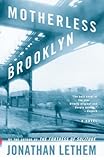I met Jonathan Lethem once. It was at the Brooklyn Book Festival some years ago and he was rocking a purple velvet sport coat and wide wale corduroy pants in a vibrant burnt-orange hue. Lethem has an unusually large head and a penetrating stare, and I recall thinking, “Huh, so this is what it would be like to meet one of my favorite authors while on acid.”
This may help explain why, though I’d read several of his novels, I could not for the life of me remember their titles.

 “The Fortress of Solitude?” Lethem asked, trying to be helpful.
“The Fortress of Solitude?” Lethem asked, trying to be helpful.
I shook my head, mortified. “Earlier, I think.”
He turned his enormous head, looking for an exit. “Um, maybe Motherless Brooklyn?”
I could have hugged him. “Yes, that’s it!” I said. “I loved that book.”
I wish this conversation had happened this year, after I had finally got around to reading The Fortress of Solitude, as it would have saved us both some embarrassment. I’m not sure why I took so long to read The Fortress of Solitude. Part of the answer, I suppose, lies in my loyalty to Lionel Essrog, the hero of Motherless Brooklyn, an amateur detective who battles hilariously with his Tourette’s outbursts as he struggles to solve a murder case. Like so many of Lethem’s characters, Lionel is a human being one misplaced brushstroke away from being a cartoon, and I was afraid that if the characterizations in Lethem’s other “big” novel were too cartoony, it might sully my affection for Lionel.
I should have known better. The Fortress of Solitude has its comic-book moments — among other things, the main characters can fly — but at its heart it is profoundly observed social novel about race and social class, set in gentrifying Brooklyn. In the early years of this century, I lived less than a mile from Boerum Hill, where the novel is set, but the Boerum Hill I knew of McLaren strollers and Smith Street boutiques was light years from the racial powder keg where Lethem’s central characters, Dylan Ebdus and Mingus Rude, grow up in the 1970s.
But what makes The Fortress of Solitude such a pleasurable, immersive read is that, while it is one of the smartest novels I know about race in America, it isn’t “about” race in America, any more than it’s “about” gentrification, or the cultural history of black music, or the War on Drugs. It’s a book about people living their lives in interesting times. Dylan, a white son of an avant-garde filmmaker, and Mingus, the black son of a semi-famous soul musician, forge a deep bond, but the world they live in fails them and they spend most of their lives apart. Even the ring that Dylan is given, which, under certain circumstances, confers magical powers onto its wearer, can’t exempt the two heroes from the very different tolls American society exacts on its black and white young men. The story of how each man tries to wriggle out of the too-small box the world has built for him makes the book impossible to put down.
More from A Year in Reading 2015
Don’t miss: A Year in Reading 2014, 2013, 2012, 2011, 2010, 2009, 2008, 2007, 2006, 2005
The good stuff: The Millions’ Notable articles
The motherlode: The Millions’ Books and Reviews
Like what you see? Learn about 5 insanely easy ways to Support The Millions, and follow The Millions on Twitter, Facebook, Tumblr.









